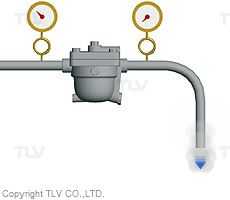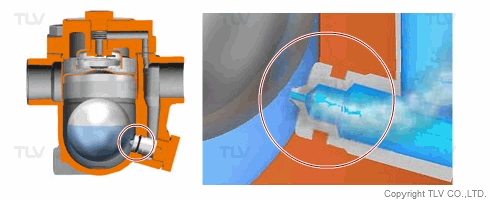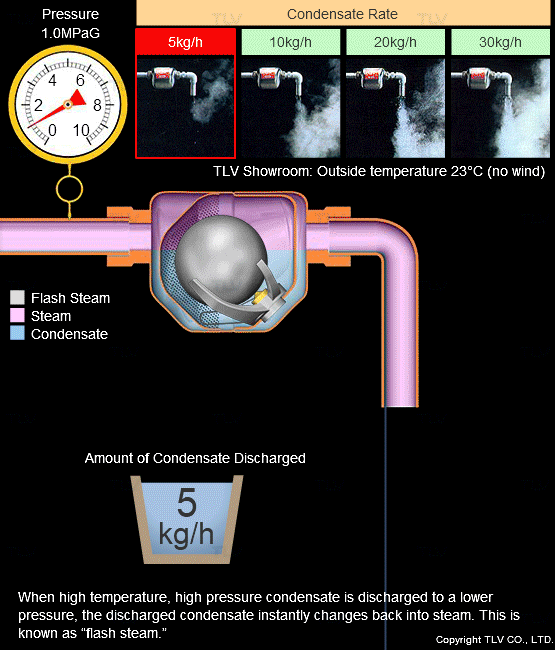- Home
- Steam Resources
- Steam Theory
- Is My Trap Leaking Live Steam?
Basics of Steam
Is My Trap Leaking Live Steam?
Have you ever wondered about the vapor clouds seen at the outlet of steam traps? These wisps of vapor can be either live steam or simply flash steam. This article aims to deepen understanding of the subtle difference between the two.
Live Steam vs. Flash Steam
Live steam is invisible, and when a trap is leaking the short distance of space between the pipe outlet and visible vapor will tend to be clear and of relatively higher velocity and force. If the vapor seen is lower velocity and appears visible immediately at the pipe outlet, then it is most likely flash steam. A quick check of the trap operation will confirm its condition.
| Trap Discharging to Atmosphere |
|---|
|
|
| Condensate discharged to atmosphere will always form a slight amount of vapor due to flash evaporation. |
Unfortunately, without checking, traps may often be misinterpreted as leaking due to the exiting vapor clouds, when in fact the vapor is just comprised of small, high energy condensate droplets that flashed at the lower outlet steam pressure.
What Causes the Vapor Clouds at the Outlet of Steam Traps?
Condensate flows through piping at a pressure higher than atmosphere. When condensate is discharged to atmosphere, a portion of it immediately evaporates because of the pressure difference. This phenomenon is know as flash evaporation.
| Flash Evaporation During Condensate Discharge |
|---|
|
|
| Condensate discharged out of the orifice of a trap partially evaporates (flash evaporation) due to the pressure difference (illustration). |
The vapor clouds at the outlet of traps appear when this flash evaporated steam (flash steam) condenses in the air to form tiny water droplets. Because of the pressure difference between the trap inlet and outlet, traps discharging hot condensate will always generate some flash steam.
The appearance of flash steam (by velocity and force) differs from live steam because when a trap is leaking live steam, the majority of the fluid exiting the trap is typically high pressure steam, which is invisible. On the other hand, with flash steam, typically only a small percentage by mass of the high pressure condensate flashes into steam due to the exit pressure drop.
How Much Vapor Is Too Much?
Flash steam vapor can appear to be a larger amount than it actually is because the difference in specific volume of flash steam compared to condensate may be over 1,500 times greater. Condensate formed at higher pressure has a corresponding higher temperature, which creates a higher % of Flash and results in greater amounts of visible vapor.
Example:
If a trap releases 10 kg/h of condensate at 1.0 MPaG to atmosphere, the amount of flash steam generated is about 1.6 kg/h. This has a volume of roughly 2.7 m3 (greater than the capacity of 2 large bathtubs). As the flash steam diffuses, it turns into a vapor cloud, which can appear to be large in volume. It's important to remember that this is not steam leakage, but condensate that has flash evaporated.
Visual Example of Properly Discharging Trap
| Discharge from Free Float® traps on a Steam Main |
|---|
|
|
In short, good condition traps can operate normally but still appear to be leaking steam because the vapor cloud often seen at the outlet of a trap is caused by the flash evaporation of condensate (flash steam). As the condensate discharge rate fluctuates, the amount of flash steam produced will also vary. When unsure whether a trap is leaking or not, a quick check of the trap condition is recommended.
Additional Note
As a note of caution, some traps (such as the bimetal-type) may be designed to have a significant amount of sub-cooling of the condensate before discharge. Significant sub-cooling can reduce the amount of visible flash steam, but sub-cooling can result in extremely long condensate back-up at the trap inlet. For applications such as steam main drip or high temperature tracing, such sub-cooling traps are not recommended. Although sub-cooling traps may exhibit less flash steam than traps with little or no sub-cooling, only non-sub-cooling traps are typically recommended for drip or high temperature tracer service to maintain safety and reliable operation.
For more information on flash steam, please refer to the article: Flash Steam.




